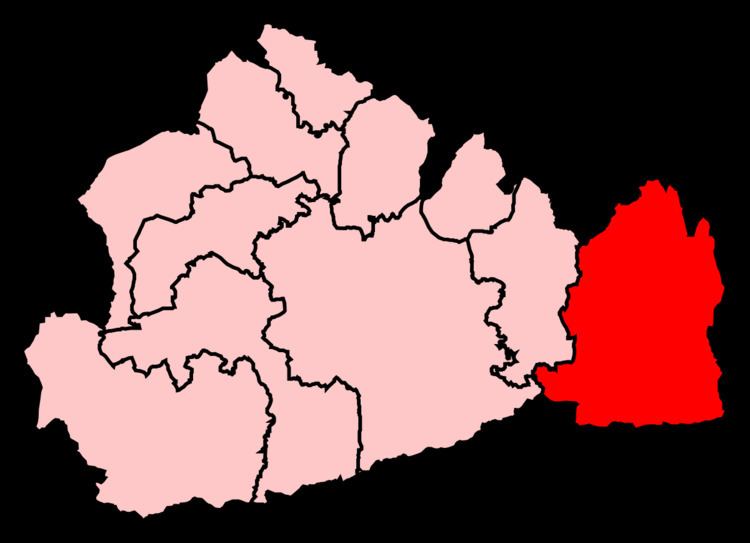Created 1918 Number of members Two | Electorate 77,145 (December 2010) Number of members One Type of constituency County constituency | |
 | ||
Major settlements Replaced by | ||
East Surrey is a constituency represented in the House of Commons of the UK Parliament since 2010 by Sam Gyimah of the Conservative Party. Its record is that of a Tory safe seat based on time and opposition. It has elected a Conservative Party MP on an absolute majority since its establishment, in 1918, and its greatest share of the vote for any opposition candidate was 33.75% in February 1974.
Contents
Boundaries
1918-1950: The Urban Districts of Caterham, and Coulsdon and Purley, and the Rural District of Godstone.
1950-1974: The Urban Districts of Caterham and Warlingham, and Coulsdon and Purley.
1974-1983: The Urban District of Caterham and Warlingham, and the Rural District of Godstone.
1983-1997: The District of Tandridge.
1997-2010: The District of Tandridge, and the Borough of Reigate and Banstead wards of Horley East and Horley West.
2010-present: The District of Tandridge, and the Borough of Reigate and Banstead wards of Horley Central, Horley East, and Horley West.
Constituency Profile
East Surrey is a well-connected inner Home Counties seat, combining the town of Horley with Surrey's residual District Tandridge (as opposed to Boroughs which the other 10 parts have been created) which is made up of Caterham and modest commuter settlements, farming and retirement homes. Horley is one of two towns adjoining London Gatwick Airport and part of Reigate and Banstead borough. The area borders the London Borough of Croydon to the north, the county of Kent to the east, and the county of West Sussex to the south.
The northern part of the seat is inside the M25 motorway — Caterham, Whyteleafe and Warlingham form green-buffered, elevated commuter belt, with good rail connections to Central London and well-connected by all modes of transport to Croydon. Elsewhere the seat is more rural and includes a low part of the Greensand Ridge and features woodland and many golf courses.
Conservatives have prevented any opposition party achieving more than 33.75% of the vote since 1974, including at the 1997 and 2001 UK General Elections when opposition was greatest nationally in Conservative safer seats.
Most local wards are won by the Conservatives with the Liberal Democrats often picking up seats somewhere in the dual-council system, particularly in Whyteleafe or Caterham Valley. As is typical in seats of this kind, the Labour vote is typically very low, with the party finishing in third place in every General Election since 1959. The early 21st century saw UKIP poll approximately as strongly as Lib Dems historically. The area saw a majority in favour of Brexit in the 2016 Referendum whereas the incumbent MP Sam Gyimah opposed Brexit.
History
The territory, reduced as neighbouring seats have been created or enlarged, on inception absorbed Surrey's parliamentary boroughs of Bletchingley and Gatton, abolished as rotten boroughs by the Great Reform Act, 1832.
An earlier constituency of the same name existed from 1832 to 1885. Formally and often known as the Eastern Division of Surrey or Surrey Eastern, it elected two MPs by the bloc vote system. It was created in the 1832 Reform Acts and covered land from Peckham and southern Brixton adjoining Southwark to Lingfield adjoining Sussex and from Kent to Capel and Kingston upon Thames, the latter adjoining one of Surrey's then western borders.
Central parts of Surrey, a county which then extended far into today's Greater London, were identified as requiring two MPs under the Second Reform Act, starting from the 1868 general election. Surrey benefited under this Reform Act 1867, which reduced malapportionment varyingly. From 1832 until 1867 the seat included a populous northern section being all of South London except for the Kentish parts of the South East London, Lambeth and Southwark.
The Redistribution of Seats Act 1885 went much further than the Reform Act 1832 towards equal representation around the country, and also reflected growth in the county's population. Thus for elections from 1885 onwards, Mid Surrey and Surrey Eastern were split into Chertsey, Croydon, Epsom, Kingston, Reigate and Wimbledon constituencies (seats formerly included in Surrey Eastern are in bold).
In 1918 the constituency was re-established as East Surrey, taking rural and at most small suburban parts of Reigate and Croydon, and for the first time electing only one MP. It covered a smaller area, from the south of Croydon to the Kent and West Sussex borders. It included Lingfield, Oxted, Limpsfield, Godstone, Caterham and Woldingham.
In 1950 East Surrey lost Addington parish on the eastern fringe of Croydon to the newly formed Croydon South constituency, and its southern half to the Reigate constituency. In 1974 much of the north of constituency became part of Croydon South, reflecting the 1965 transfer of Purley and Coulsdon to the London Borough of Croydon in the new Greater London which then replaced the London County Council. Surrey East took in much of the area to the south that had been in Reigate since 1950. Its MP until 1974, William Clark, won the new Croydon South in that year's February election. Clark's successor, Sir Geoffrey Howe, later became Chancellor of the Exchequer and Foreign Secretary in Margaret Thatcher's cabinet.
Elections in the 1990s
This constituency underwent boundary changes between the 1992 and 1997 general elections and thus change in share of vote is based on a notional calculation.
Elections in the 1930s
General Election 1939/40:
Another General Election was required to take place before the end of 1940. The political parties had been making preparations for an election to take place from 1939 and by the end of this year, the following candidates had been selected;
